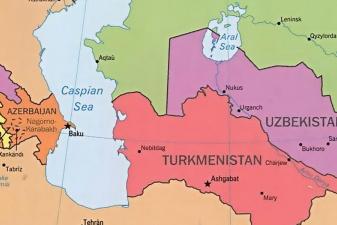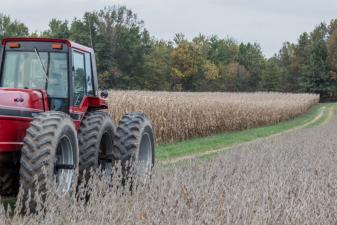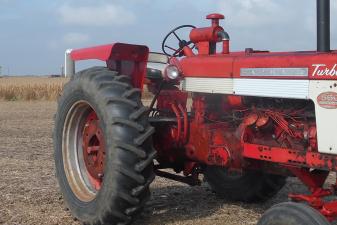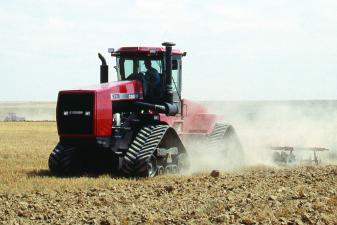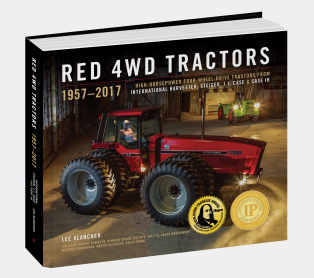Designing the 1482, Part 2
By Ken Blaha, former IH Engineer

In this excerpt, former IH Engineer Ken Blaha chronicles the design, development, and production of the 1482 pull-type combine. Blaha’s seven-year career with IH was devoted entirely to 1482 development, from 1974 to 1981. Filled with trials, errors, successes, and lessons, this step-by-step narrative provides a comprehensive view of the creation and perfection of an industry-changing combine.
This excerpt is continued from last week's blog post, Designing the 1482, Part One.
PART TWO
This brings us to the fall of 1976, and CX-38 number one is ready for field test. A 1566 is chosen as the power source and one is ordered. The tractor and combine are shipped to Sasketchewan, Canada for test. The combine is unmarked, just a big red pull-type combine. I soon got my first chance to go to Canada to observe the CX-38 in action. By this time, it is becoming evident that the CX-38/1482 is my machine. Everything required to convert a 1480 into a 1482 has passed through me in one form or another. Even the grain tank, which at 245 bushels was bigger than the 1480, needed my help at one point.
This first trip turned into a very memorable time. We stayed in Regina, Sasketchewan. One day, when we got back to the motel, we found a Massey Ferguson 760 test model on a transporter going somewhere for test. The driver was pretty talkative, and told us about a green 4WD he had transported that had some major engine problems to fix before production. Another day, we passed a New Holland TR70 that had been converted into a pull-type. I wish that I had those pictures. The farmer that we were working with at the time was harvesting wheat on former Indian Reservation land that had just been cleared for its first crop. The fertile land was producing a bumper crop and was a good place to test. The combine performed well for its first time out. On the other hand, we found out very quickly that having to run the tractor at part throttle to maintain standard PTO speed had a negative effect on performance, something to consider for the future.
The most memorable event on this trip was the day that we wanted to take stress measurements on the machine with a full grain tank. As soon as they got the tank filled, they turned out of the windrow and headed back to the testers. As they went through a low area in the field, suddenly the bottom fell out from beneath them, and they stopped dead in their tracks.The combine was sitting on its frame and the tractor drawbar just barely cleared the ground. They were stuck with a capital S. First, they tried to empty the grain tank. They backed up a truck and started unloading. In short order, the truck started sinking, so they called that off. Then they brought in the farmer's Ford 6000. That didn't even move it. The farmer then told his son to go get the bulldozer that they had used to clear the land. The son's argument about it not having an air cleaner didn't matter, just get it. The dozer was an old Allis-Chalmers, probably either an HD-11 or an HD-16. They dropped a cable under the tractor and hooked it to the drawbar. A short pull and the combine popped out just as quickly as it went down. It left behind two holes with tire prints in them. My frame had survived its first real field test. I learned later that they got stuck once more that season. That second time, they pulled it out by pulling sideways on the tongue. My frame survived that, too. I just wonder how much the tongue curved during that pullout. We had already found out during testing that because of its length, there were times that you could actually see the tongue bend, even though stresses were no where near problem levels.
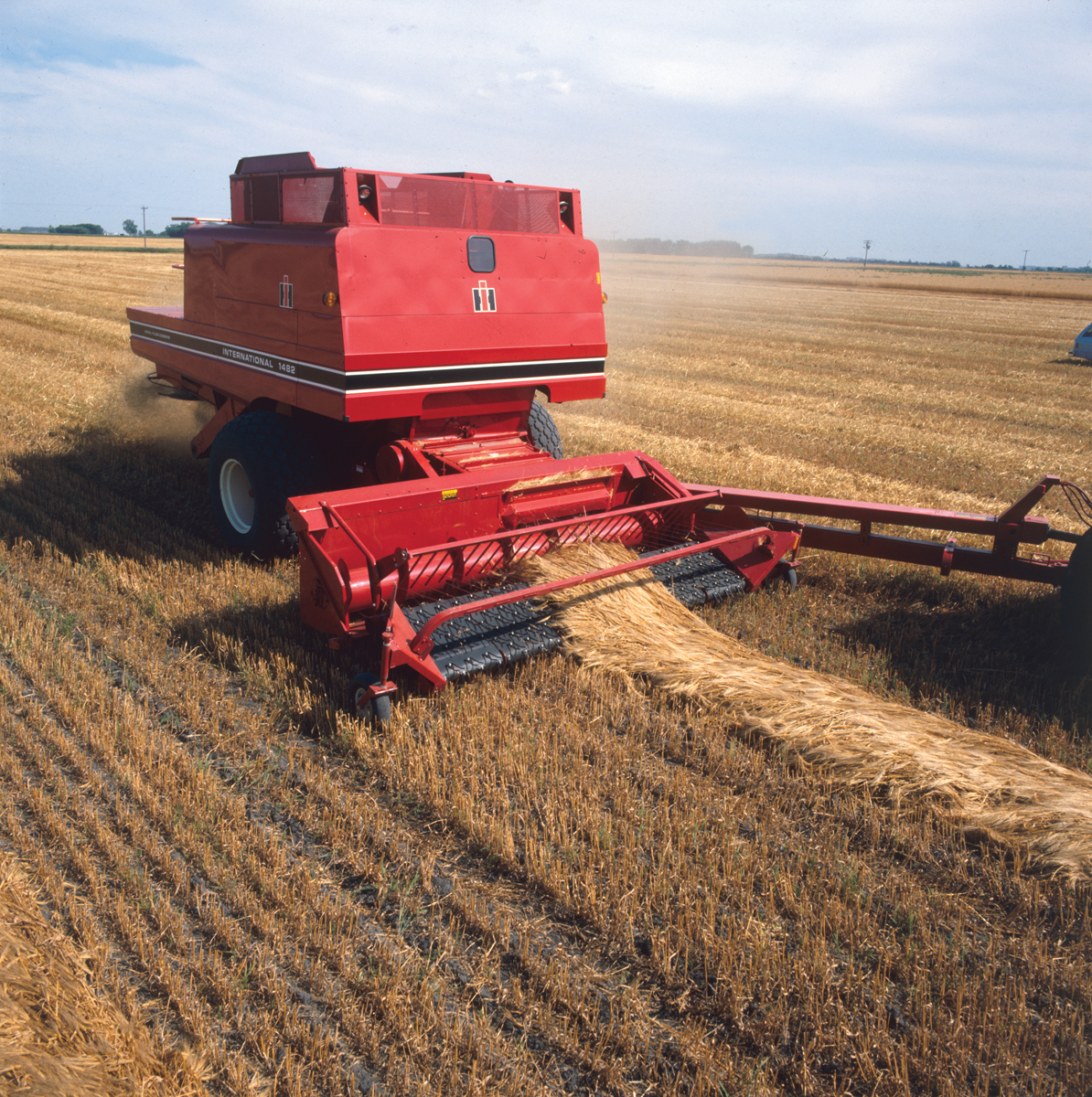
Hydraulics remotely controlled the header height, rell height, and the unloading auger. This 1482 pull-type combine was pulled through barley windrows by a 5488 tractor with duals. Image taken August 19, 1982, near Grand Forks, North Dakota. Wisconsin Historical Society #114837. This image appears in Red Combines by Lee Klancher et al.
At the end of the season, the combine and tractor were brought back to East Moline. The combine was updated and repaired as needed for the 1977 season. This time, it was going out for a full season, starting in Arizona in June threshing irrigated wheat, and ending up in Edmonton, Alberta. It was actually driven from Sasketchewan up to the Edmonton area. You should have seen the tires when it got back. Similar to what was used on the 914, the left wheel was toed in to help the combine track properly in the field. Both wheels have camber to insure that they are vertical under load providing proper loading. After all those road miles, the right tire was worn almost bald. Obviously, since the left side of the machine is heavier, the toed in left wheel was pushing the right wheel.
At this point in time, there was one other new design project that needed completion before the CX-38 became the production 1482. That was the 17.5 ft. direct cut header. This was relatively easy to do and was completed quickly. After testing, we found a couple of areas that needed beefing up, and these were taken care of. This is the header that was used in Arizona, and then it was later tested in the Dakotas with a sunflower attachment. Once set right, the CX-38 could really fly through sunflowers, easily running 5-7 MPH.
After another round of updates, the CX-38 went to the field in 1978 with a different tractor. We got one of the early 3588 2+2's to run it. I remember that the serial number last four digits were written on the frame in chalk. I'm pretty sure that it was #8808, the 8th one built. I made two field trips that year, one to South Dakota and the other back to Sasketchewan. My first chance to drive that tractor was in South Dakota while transporting from one farm to another. One thing became obvious very quickly, don't watch the hood to try to keep the tractor going straight. I ended up doing a slow slalom when I tried that. Just watch the road.
After I had been cruising along for quite a while, the tractor started lugging down a bit, and then I started to smell something hot. I pulled off to the side of the road, stopped, and waited for the tester to come. When he did, we found a friendly farmer where we could park the tractor and combine and call for help. The dealer that later repaired the tractor told us that one of the bearings on the driveshaft through the pivot area had burned out. It was no big deal until we found out that Hinsdale engineering knew that it would be a problem, but gave us the tractor anyway. I'm sure that some hot words were exchanged between my boss and the Hinsdale engineers at that point.
I drove that tractor some more on the trip to Canada. I actually had a couple of days of production combining. For the time, that thing could really put through some grain. During that trip on one of the moves, we pulled in to one farmer's field late in the afternoon. The weather was very overcast, almost to the point of being foggy. The farmer had just tried his green machine and quit because he was losing too much out the back. We went in and ran with no such problem, but we also stopped due to high moisture content in the grain. Tough conditions like that made the axial-flow really shine.
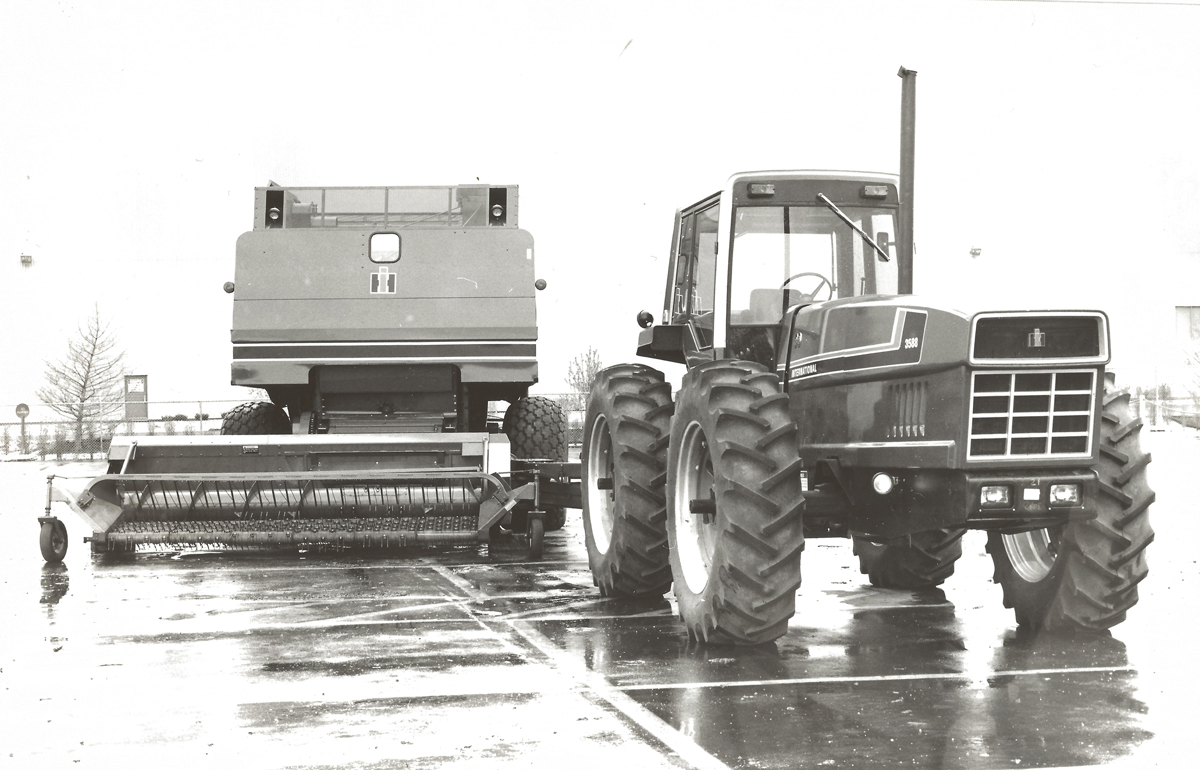
The last year before production, 1979, we ran two fully marked 1482 combines and used two new 86 series tractors. One of the tractors chosen was a production 1086 with dual wheels. It represented the minimum size (130 PTO HP) that we would recommend for operating the 1482, and it also represented the maximum width of tractor. The other tractor we chose was a custom built 1586. We wanted a tractor that would really be able to work the 1482, and we got it. From outward appearances, the only things odd about this 1586 were the 30.5x32 rear tires and a plastic radiator overflow tank that didn't fit under the hood. And under that hood was a DTI-466 engine, set up to put out 185 HP at the PTO at standard PTO speed, with this speed also being set as the rated speed. This made the tractor easy to drive with the combine. All you had to do was push the throttle wide open and go. No fiddling around to set the correct PTO speed, as we had to do with the 1566 and the other tractors. Compared to a standard 1586, this one put out about 30 HP more, or 20%. Looking at Nebraska Tractor Test results, the 1586 used a DT-436 engine to get 161 PTO HP at 2500 engine RPM, but this dropped to 155 PTO HP at 2100 engine RPM for standard PTO speed. I don't know whatever happened to this tractor, but if somebody has it and wonders why the overflow tank, the engine is the reason.
By this time, the bugs had pretty well been worked out and plans were in place for production for the 1980 harvest season. In December, 1979, we presented two papers at the ASAE (American Society of Agricultural Engineers) fall conference, one on the 1482 and one on the plastic modeling we had done to analyze the frame. I did get one more trip to Canada to get some more hours on the machine. For the harvesting that I did, I drove the 1586. Of course, it had plenty of power but was a little slow for transport because of the slower engine speed. The one thing that I do remember about that trip is that we transported both machines to the farm where some of the pictures in the advertising brochure were taken. We had been using rotary screens on the radiators of both tractors, but on the move the 1086 dropped its screen and the combine finished it off. The picture in the brochure of both combines in the field has been airbrushed to remove the rotary screens from the 1586.

The 1482 used the 30-inch rotor from the 1480 combine and had a 245-bushel grain tank. The big 1482 was PTO-driven and required a tractor with at elast 130 hp to operate it. This 1482 pull-type combine was photographed harvesting wheat in the Dakotas in early fall 1978. Wisocnsin Historical Society #114839. This image appears in Red Combines by Lee Klancher et al.
1980 turned out to be kind of a down year as a designer. The 1482 was now in production and, hopefully, no big problems would show up. We added a straw chopper option to the machine, so I had to work up a drive for that, but there wasn't much else. I guess the real highlight of the year was a field trip to visit the new owners of my baby. That was a delightful trip. Over half of the machines we visited were being operated with the big 4WD articulated tractors. I don't remember hearing any complaints. We visited one that was being operated by a small looking Hydro 100 on some nice flat fields. They reassured us that this was not a problem since it had been turned up a quite a bit. Another was being operated by an Allis-Chalmers 7580, and it was just cruising right along. The farmer was nice enough to stop and allow us to ask our questions. I remember that at this stop, I went over to test the temperature of the main gearbox. I found it to be just pleasantly warm. We visited one being operated by an 8600 series Deere in some rather hillly conditions. His only comments were that he needed the big tractor for the hills, and sometimes he could actually see the bottom of the grain tank. Probably the most memorable was the farmer harvesting barley right next to the farmstead. His only problem was that he would fill the grain tank in about 12 minutes, but then he would have to sit and wait for the grain truck to come back.
The next year, 1981, saw the end of my career with "Big Red". It had been a real accomplishment to take the 1482 from first concept to full production, something that I am still proud of having done. Now it was time to start working on the next version. This was actually progressing quite well. I had three contract people working for me and things were coming together until one day we were called together very suddenly. It seems that the highest ranking technical officer for the company (I forgot his name, but he was ex-Deere) strongly believed in centralized engineering. As a result, we were given the option of quitting or moving to Hinsdale, because that is where our jobs were going. I opted out. I wasn't looking forward to living in the big city with its high cost of living. I did have a conversation with the relocation service, and found that my $26,000 house would probably cost me $60,000 up there, and there would be no pay increase. In fact, I learned later that there actually was a pay cut. "Big Red" lost some good talent during that time. There were 6 or 8 others who did the same thing that I did. The unbelievable thing is that I am still working with one of those guys, only now we are both working for Caterpillar. He, being younger than me, is still there. I retired in 2013.
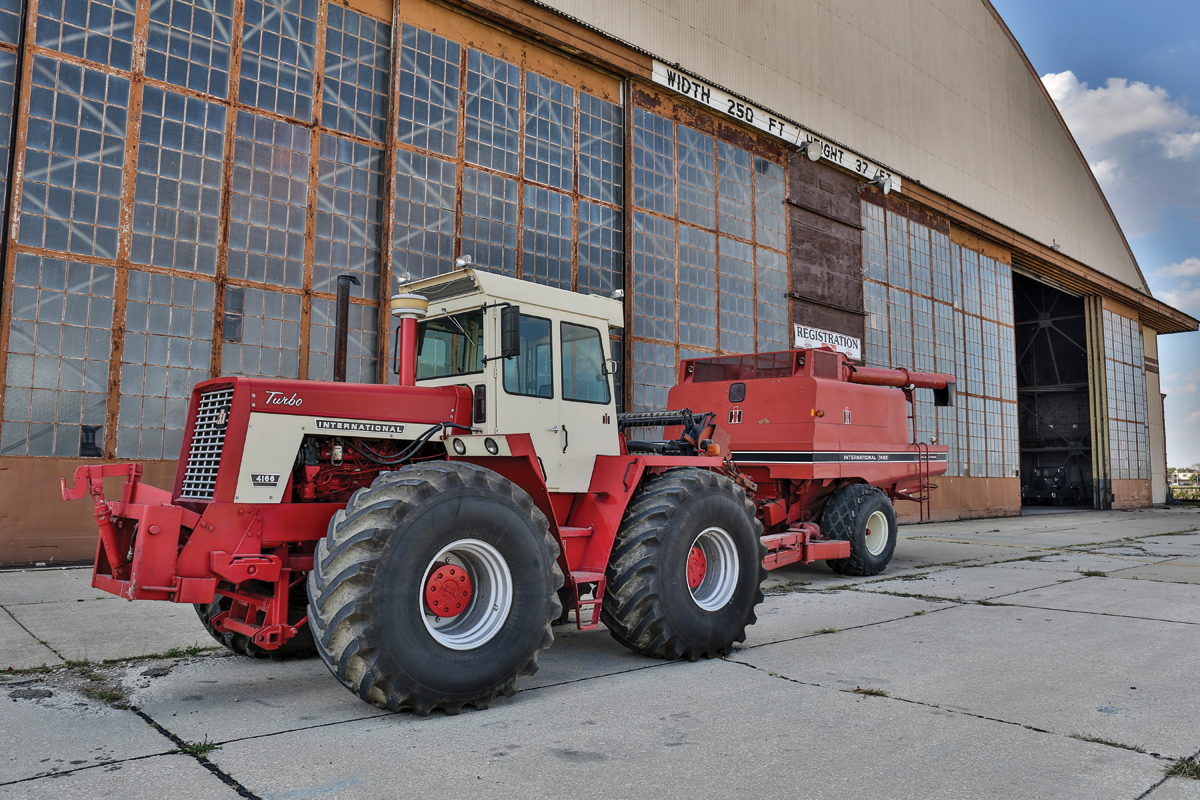
Introduced in 1980, the 1482 was far and away the largest pull-behind combine on the market and it came at a time when an upgrade of Harvester's pull-behind model was long overdue. This one, as well as the 4166 tractor, is owned by Darius Harms, and was photographed on the former Air Force base in Rantoul, Illinois, that serves as the grounds for the Half Century of Progress tractor show. Lee Klancher
---------------------------------
Learn more about all of your favorite IH combines in Red Combines, by Lee Klancher et al.
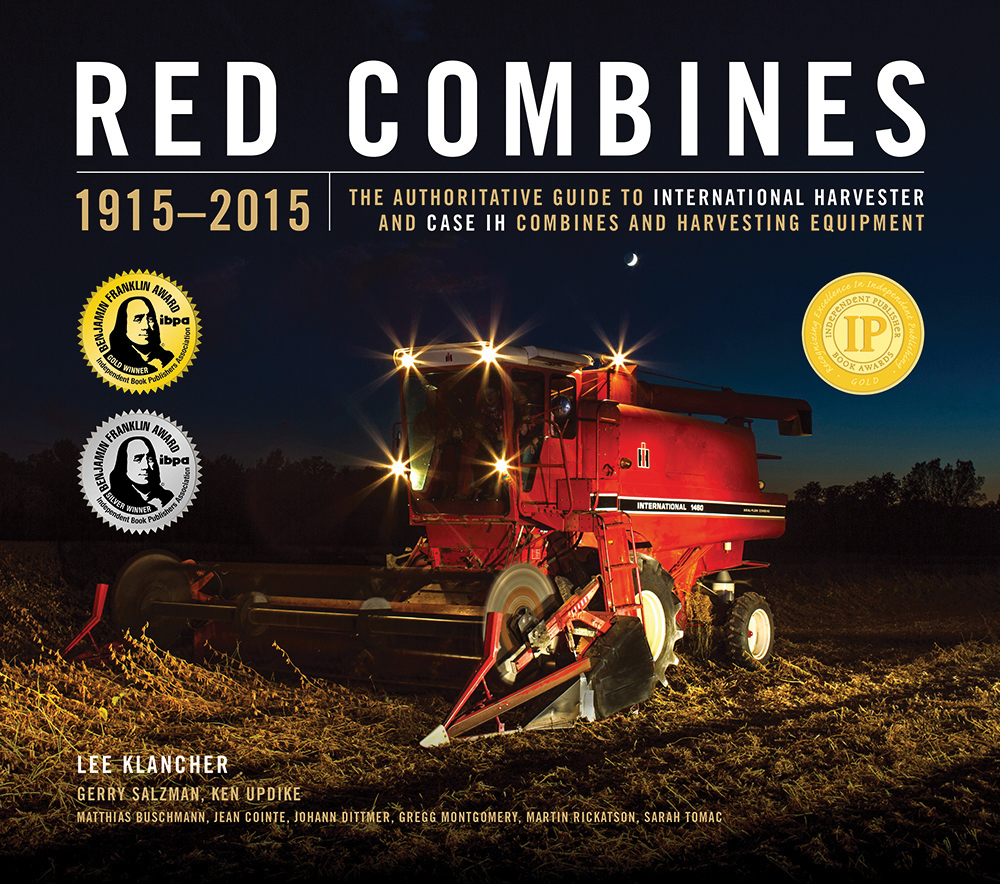
This article has also appeared in Red Power Magazine in an alternately edited version.
This excerpt is continued from last week's blog post, Designing the 1482, Part One.
PART TWO
This brings us to the fall of 1976, and CX-38 number one is ready for field test. A 1566 is chosen as the power source and one is ordered. The tractor and combine are shipped to Sasketchewan, Canada for test. The combine is unmarked, just a big red pull-type combine. I soon got my first chance to go to Canada to observe the CX-38 in action. By this time, it is becoming evident that the CX-38/1482 is my machine. Everything required to convert a 1480 into a 1482 has passed through me in one form or another. Even the grain tank, which at 245 bushels was bigger than the 1480, needed my help at one point.
This first trip turned into a very memorable time. We stayed in Regina, Sasketchewan. One day, when we got back to the motel, we found a Massey Ferguson 760 test model on a transporter going somewhere for test. The driver was pretty talkative, and told us about a green 4WD he had transported that had some major engine problems to fix before production. Another day, we passed a New Holland TR70 that had been converted into a pull-type. I wish that I had those pictures. The farmer that we were working with at the time was harvesting wheat on former Indian Reservation land that had just been cleared for its first crop. The fertile land was producing a bumper crop and was a good place to test. The combine performed well for its first time out. On the other hand, we found out very quickly that having to run the tractor at part throttle to maintain standard PTO speed had a negative effect on performance, something to consider for the future.
The most memorable event on this trip was the day that we wanted to take stress measurements on the machine with a full grain tank. As soon as they got the tank filled, they turned out of the windrow and headed back to the testers. As they went through a low area in the field, suddenly the bottom fell out from beneath them, and they stopped dead in their tracks.The combine was sitting on its frame and the tractor drawbar just barely cleared the ground. They were stuck with a capital S. First, they tried to empty the grain tank. They backed up a truck and started unloading. In short order, the truck started sinking, so they called that off. Then they brought in the farmer's Ford 6000. That didn't even move it. The farmer then told his son to go get the bulldozer that they had used to clear the land. The son's argument about it not having an air cleaner didn't matter, just get it. The dozer was an old Allis-Chalmers, probably either an HD-11 or an HD-16. They dropped a cable under the tractor and hooked it to the drawbar. A short pull and the combine popped out just as quickly as it went down. It left behind two holes with tire prints in them. My frame had survived its first real field test. I learned later that they got stuck once more that season. That second time, they pulled it out by pulling sideways on the tongue. My frame survived that, too. I just wonder how much the tongue curved during that pullout. We had already found out during testing that because of its length, there were times that you could actually see the tongue bend, even though stresses were no where near problem levels.

Hydraulics remotely controlled the header height, rell height, and the unloading auger. This 1482 pull-type combine was pulled through barley windrows by a 5488 tractor with duals. Image taken August 19, 1982, near Grand Forks, North Dakota. Wisconsin Historical Society #114837. This image appears in Red Combines by Lee Klancher et al.
At the end of the season, the combine and tractor were brought back to East Moline. The combine was updated and repaired as needed for the 1977 season. This time, it was going out for a full season, starting in Arizona in June threshing irrigated wheat, and ending up in Edmonton, Alberta. It was actually driven from Sasketchewan up to the Edmonton area. You should have seen the tires when it got back. Similar to what was used on the 914, the left wheel was toed in to help the combine track properly in the field. Both wheels have camber to insure that they are vertical under load providing proper loading. After all those road miles, the right tire was worn almost bald. Obviously, since the left side of the machine is heavier, the toed in left wheel was pushing the right wheel.
At this point in time, there was one other new design project that needed completion before the CX-38 became the production 1482. That was the 17.5 ft. direct cut header. This was relatively easy to do and was completed quickly. After testing, we found a couple of areas that needed beefing up, and these were taken care of. This is the header that was used in Arizona, and then it was later tested in the Dakotas with a sunflower attachment. Once set right, the CX-38 could really fly through sunflowers, easily running 5-7 MPH.
After another round of updates, the CX-38 went to the field in 1978 with a different tractor. We got one of the early 3588 2+2's to run it. I remember that the serial number last four digits were written on the frame in chalk. I'm pretty sure that it was #8808, the 8th one built. I made two field trips that year, one to South Dakota and the other back to Sasketchewan. My first chance to drive that tractor was in South Dakota while transporting from one farm to another. One thing became obvious very quickly, don't watch the hood to try to keep the tractor going straight. I ended up doing a slow slalom when I tried that. Just watch the road.
After I had been cruising along for quite a while, the tractor started lugging down a bit, and then I started to smell something hot. I pulled off to the side of the road, stopped, and waited for the tester to come. When he did, we found a friendly farmer where we could park the tractor and combine and call for help. The dealer that later repaired the tractor told us that one of the bearings on the driveshaft through the pivot area had burned out. It was no big deal until we found out that Hinsdale engineering knew that it would be a problem, but gave us the tractor anyway. I'm sure that some hot words were exchanged between my boss and the Hinsdale engineers at that point.
I drove that tractor some more on the trip to Canada. I actually had a couple of days of production combining. For the time, that thing could really put through some grain. During that trip on one of the moves, we pulled in to one farmer's field late in the afternoon. The weather was very overcast, almost to the point of being foggy. The farmer had just tried his green machine and quit because he was losing too much out the back. We went in and ran with no such problem, but we also stopped due to high moisture content in the grain. Tough conditions like that made the axial-flow really shine.

The last year before production, 1979, we ran two fully marked 1482 combines and used two new 86 series tractors. One of the tractors chosen was a production 1086 with dual wheels. It represented the minimum size (130 PTO HP) that we would recommend for operating the 1482, and it also represented the maximum width of tractor. The other tractor we chose was a custom built 1586. We wanted a tractor that would really be able to work the 1482, and we got it. From outward appearances, the only things odd about this 1586 were the 30.5x32 rear tires and a plastic radiator overflow tank that didn't fit under the hood. And under that hood was a DTI-466 engine, set up to put out 185 HP at the PTO at standard PTO speed, with this speed also being set as the rated speed. This made the tractor easy to drive with the combine. All you had to do was push the throttle wide open and go. No fiddling around to set the correct PTO speed, as we had to do with the 1566 and the other tractors. Compared to a standard 1586, this one put out about 30 HP more, or 20%. Looking at Nebraska Tractor Test results, the 1586 used a DT-436 engine to get 161 PTO HP at 2500 engine RPM, but this dropped to 155 PTO HP at 2100 engine RPM for standard PTO speed. I don't know whatever happened to this tractor, but if somebody has it and wonders why the overflow tank, the engine is the reason.
By this time, the bugs had pretty well been worked out and plans were in place for production for the 1980 harvest season. In December, 1979, we presented two papers at the ASAE (American Society of Agricultural Engineers) fall conference, one on the 1482 and one on the plastic modeling we had done to analyze the frame. I did get one more trip to Canada to get some more hours on the machine. For the harvesting that I did, I drove the 1586. Of course, it had plenty of power but was a little slow for transport because of the slower engine speed. The one thing that I do remember about that trip is that we transported both machines to the farm where some of the pictures in the advertising brochure were taken. We had been using rotary screens on the radiators of both tractors, but on the move the 1086 dropped its screen and the combine finished it off. The picture in the brochure of both combines in the field has been airbrushed to remove the rotary screens from the 1586.

The 1482 used the 30-inch rotor from the 1480 combine and had a 245-bushel grain tank. The big 1482 was PTO-driven and required a tractor with at elast 130 hp to operate it. This 1482 pull-type combine was photographed harvesting wheat in the Dakotas in early fall 1978. Wisocnsin Historical Society #114839. This image appears in Red Combines by Lee Klancher et al.
1980 turned out to be kind of a down year as a designer. The 1482 was now in production and, hopefully, no big problems would show up. We added a straw chopper option to the machine, so I had to work up a drive for that, but there wasn't much else. I guess the real highlight of the year was a field trip to visit the new owners of my baby. That was a delightful trip. Over half of the machines we visited were being operated with the big 4WD articulated tractors. I don't remember hearing any complaints. We visited one that was being operated by a small looking Hydro 100 on some nice flat fields. They reassured us that this was not a problem since it had been turned up a quite a bit. Another was being operated by an Allis-Chalmers 7580, and it was just cruising right along. The farmer was nice enough to stop and allow us to ask our questions. I remember that at this stop, I went over to test the temperature of the main gearbox. I found it to be just pleasantly warm. We visited one being operated by an 8600 series Deere in some rather hillly conditions. His only comments were that he needed the big tractor for the hills, and sometimes he could actually see the bottom of the grain tank. Probably the most memorable was the farmer harvesting barley right next to the farmstead. His only problem was that he would fill the grain tank in about 12 minutes, but then he would have to sit and wait for the grain truck to come back.
The next year, 1981, saw the end of my career with "Big Red". It had been a real accomplishment to take the 1482 from first concept to full production, something that I am still proud of having done. Now it was time to start working on the next version. This was actually progressing quite well. I had three contract people working for me and things were coming together until one day we were called together very suddenly. It seems that the highest ranking technical officer for the company (I forgot his name, but he was ex-Deere) strongly believed in centralized engineering. As a result, we were given the option of quitting or moving to Hinsdale, because that is where our jobs were going. I opted out. I wasn't looking forward to living in the big city with its high cost of living. I did have a conversation with the relocation service, and found that my $26,000 house would probably cost me $60,000 up there, and there would be no pay increase. In fact, I learned later that there actually was a pay cut. "Big Red" lost some good talent during that time. There were 6 or 8 others who did the same thing that I did. The unbelievable thing is that I am still working with one of those guys, only now we are both working for Caterpillar. He, being younger than me, is still there. I retired in 2013.

Introduced in 1980, the 1482 was far and away the largest pull-behind combine on the market and it came at a time when an upgrade of Harvester's pull-behind model was long overdue. This one, as well as the 4166 tractor, is owned by Darius Harms, and was photographed on the former Air Force base in Rantoul, Illinois, that serves as the grounds for the Half Century of Progress tractor show. Lee Klancher
---------------------------------
Learn more about all of your favorite IH combines in Red Combines, by Lee Klancher et al.

This article has also appeared in Red Power Magazine in an alternately edited version.


